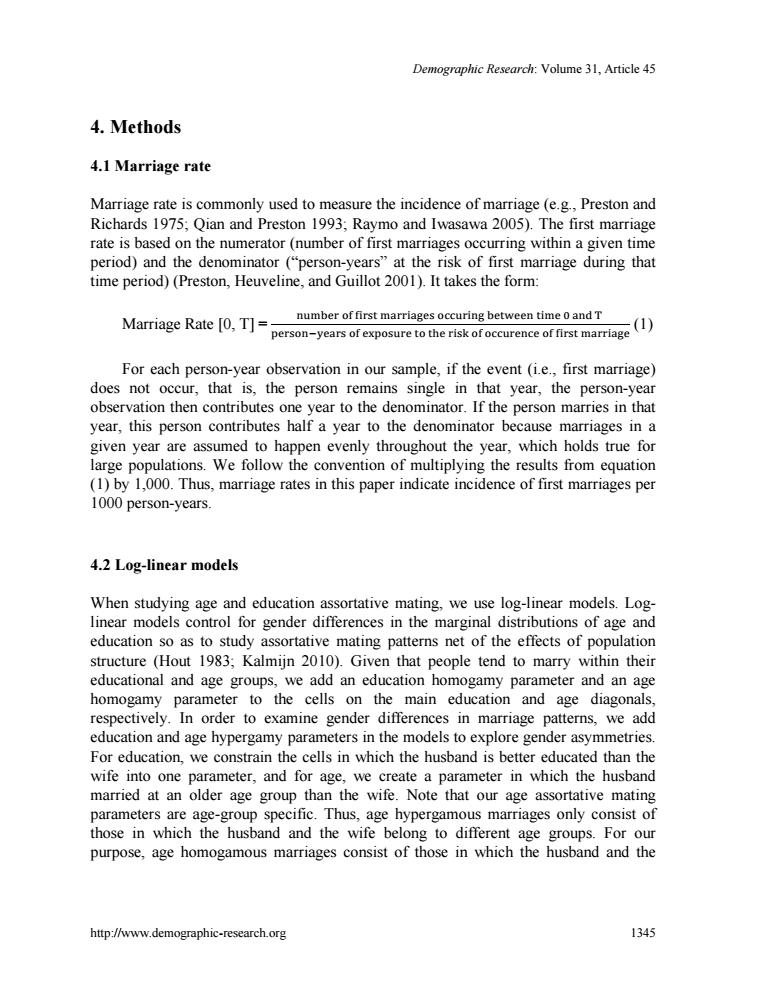正在加载图片...

Demographic Research:Volume 31,Article 45 4.Methods 4.1 Marriage rate Marriage rate is commonly used to measure the incidence of marriage (e.g.,Preston and Richards 1975;Qian and Preston 1993;Raymo and Iwasawa 2005).The first marriage rate is based on the numerator(number of first marriages occurring within a given time period)and the denominator ("person-years"at the risk of first marriage during that time period)(Preston,Heuveline,and Guillot 2001).It takes the form: Marriage Rate [O,T]=- number of first marriages occuring between time 0 and T person-years of exposure to the risk of occurence of first marriage (1) For each person-year observation in our sample,if the event (i.e.,first marriage) does not occur,that is,the person remains single in that year,the person-year observation then contributes one year to the denominator.If the person marries in that year,this person contributes half a year to the denominator because marriages in a given year are assumed to happen evenly throughout the year,which holds true for large populations.We follow the convention of multiplying the results from equation (1)by 1,000.Thus,marriage rates in this paper indicate incidence of first marriages per 1000 person-years. 4.2 Log-linear models When studying age and education assortative mating,we use log-linear models.Log- linear models control for gender differences in the marginal distributions of age and education so as to study assortative mating patterns net of the effects of population structure (Hout 1983;Kalmijn 2010).Given that people tend to marry within their educational and age groups,we add an education homogamy parameter and an age homogamy parameter to the cells on the main education and age diagonals, respectively.In order to examine gender differences in marriage patterns,we add education and age hypergamy parameters in the models to explore gender asymmetries. For education,we constrain the cells in which the husband is better educated than the wife into one parameter,and for age,we create a parameter in which the husband married at an older age group than the wife.Note that our age assortative mating parameters are age-group specific.Thus,age hypergamous marriages only consist of those in which the husband and the wife belong to different age groups.For our purpose,age homogamous marriages consist of those in which the husband and the http://www.demographic-research.org 1345Demographic Research: Volume 31, Article 45 http://www.demographic-research.org 1345 4. Methods 4.1 Marriage rate Marriage rate is commonly used to measure the incidence of marriage (e.g., Preston and Richards 1975; Qian and Preston 1993; Raymo and Iwasawa 2005). The first marriage rate is based on the numerator (number of first marriages occurring within a given time period) and the denominator (“person-years” at the risk of first marriage during that time period) (Preston, Heuveline, and Guillot 2001). It takes the form: Marriage Rate [0, T] = (1) For each person-year observation in our sample, if the event (i.e., first marriage) does not occur, that is, the person remains single in that year, the person-year observation then contributes one year to the denominator. If the person marries in that year, this person contributes half a year to the denominator because marriages in a given year are assumed to happen evenly throughout the year, which holds true for large populations. We follow the convention of multiplying the results from equation (1) by 1,000. Thus, marriage rates in this paper indicate incidence of first marriages per 1000 person-years. 4.2 Log-linear models When studying age and education assortative mating, we use log-linear models. Loglinear models control for gender differences in the marginal distributions of age and education so as to study assortative mating patterns net of the effects of population structure (Hout 1983; Kalmijn 2010). Given that people tend to marry within their educational and age groups, we add an education homogamy parameter and an age homogamy parameter to the cells on the main education and age diagonals, respectively. In order to examine gender differences in marriage patterns, we add education and age hypergamy parameters in the models to explore gender asymmetries. For education, we constrain the cells in which the husband is better educated than the wife into one parameter, and for age, we create a parameter in which the husband married at an older age group than the wife. Note that our age assortative mating parameters are age-group specific. Thus, age hypergamous marriages only consist of those in which the husband and the wife belong to different age groups. For our purpose, age homogamous marriages consist of those in which the husband and the